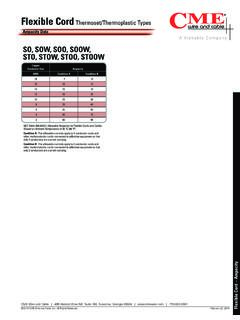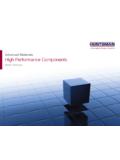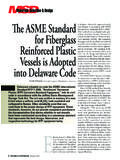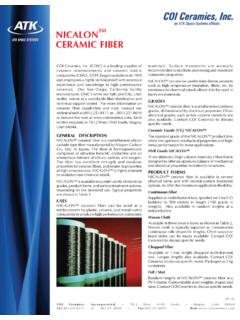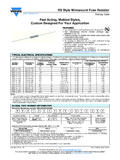Transcription of Thermoset Processing Manual Compression Molding
1 3/10/2010 Chemiplastica1 Thermoset Processing ManualCompression Molding3/10/20102 ChemiplasticaGeneral Overview3/10/20103 ChemiplasticaDescription Urochem-Compounded from Urea Formaldehyde Resin, Cellulose Filler, Pigments, Flow Promoters ,lubricants Melochem- Compounded from Melamine Formaldehyde Resin, Cellulose Filler, Pigments, Flow Promoters ,lubricants Fenochem- Compounded from Phenolic Resin, organic and inorganic fillers, Pigments, Flow promoters, Lubricants3/10/20104 ChemiplasticaMaterial Properties Flow-Measures how fluid and soft material is. Lower Number= Easier Flow. Cure Value- Measures how fast material is formed into a Blister Free Part . Density- Measurement of weight per volume. Good data for charge weight considerations. Typical Urochem range 64 +/- 4 grams/100 FIRSTG uide to Safety Around The PressAnd Machinery3/10/20106 ChemiplasticaTen Commandments of Safety Safety Glasses & Ear Protection No Loose clothing, Neckties/Necklace outside clothing Turn off all electrical switches when investigating malfunction Never use Compressed air Gunto clean hands or clothing3/10/20107 ChemiplasticaTen Commandments of Safety Know Location of Fire Extinguisher Do not tie down or Block Safety Switch Do not reach around or remove safety guards Before starting press Make sure all people are clear of moving parts Maintain good housekeeping and avoid dust collection3/10/2010 Chemiplastica8 Thermoset Molding TermsCompressionMolding3/10/20109 ChemiplasticaTerms & DefinitionsBlisterRaised Section in molded part Gas Trap Under cure or overcureBreathe (Degassing)
2 Opening and closing of mold to allow escape of gasCavityPart of mold which forms outer surface of molded partChargeAmount of material required to fill cavityCharging The MoldPlacing required amount in mold. Only automatic at & DefinitionsCureTime required to polymerize to a hard blister free surface under heat and pressureCycleTime it takes to complete one operation Loading and close of mold Breathe cycle Open and discharge of partsDraftAmount of taper on side of mold/molded part for easy removalEjector PinsSteel pins in cavity or force for removal of parts3/10/201011 ChemiplasticaTerms & DefinitionsFamily MoldA multi-cavity mold containing several cavities of different sizes and shapesFlashThe excess material that flows out of the mold cavity under pressureGuide PinsPin or bars in mold to assure proper alignment of mold halvesParting LinePart of mold which provides the cut-off of the flash from molded partPlasticity/FlowTerm to describe degree that material flow under heat and pressure3/10/201012 ChemiplasticaTerms & DefinitionsPlatensTop and bottom
3 Plates on press to which mold halves are boltedPolymerizationChemical reaction that starts with closing of mold and ends with cure of partPressure PadsSteel blocks outside cavity which meet during mold closure to prevent tooling contact at parting lineVe n tSmall channels of groves to allow air and gas to escape during molding3/10/2010 Chemiplastica13 Material HandlingStorage and Rotation3/10/201014 ChemiplasticaMaterial Handling Store material in cool, dry place First in first out (limited shelf life) Verify material before loading Use single batch at a time Avoid mixing batches Avoid contamination Avoid pressurized air for cleaning Maintain good housekeeping Shield presses running light colors from dark colors3/10/2010 Chemiplastica15 Compression MoldingGeneral Overview3/10/201016 ChemiplasticaCompression Molding Molding of Thermoset plastic using a Compression press Two halves of mold brought together under high pressure Mold is heated at 290-350 F depending on material Application of required breathe cycle Temperature and pressure cause material to melt and flow into spaces between cavity and force Material is set and ejected after appropriate cure time3/10/201017 ChemiplasticaCompression Press Molding press consisting of hydraulic ram housed in large cylinder Cylinder located at bottom for upward acting press and in the top for downward Hydraulic pressure
4 Drives ram with platen and mold halves attached Force is applied depending on size of mold and output size of press3/10/201018 ChemiplasticaMolding Temperatures Urea Molding compound, Urochem 290 to 310 F Melamine Molding compound, Melochem 310 to 350 F Phenolic Molding compound, Fenochem 325 to 350 F3/10/201019 ChemiplasticaPress Controls Understand function of all controls, buttons, switches prior to operating press Always be aware of the location of emergency button/controls Never touch any unfamiliar controls Always use safety devices3/10/2010 Chemiplastica20 Compression Molding ProcessStep-By-Step Start Up Guide3/10/201021 ChemiplasticaSTEP ONEV erify double load safeties are functional& Properly set. This ensures Molding process remains in low pressure until the mold closes to the proper position. If there is a part or foreign object stuck in the mold, the press cannot close to safety position and go into high pressure.
5 These safeties are actually part of the Molding process3/10/201022 ChemiplasticaStep TWO Check mold temperature with pyrometer290 to 310 F for urea5 to 10 degrees lower in cavity part Check that temperature is even across cavities and make adjustments. If temperature is not correct, contact supervisor to ensure thermocouples are properly working Maintaining correct temperature is essential to quality and workmanship3/10/201023 ChemiplasticaSTEP THREECLOSE MOLD EMPTY AND CHECK TO ENSURE PSI IS WITHIN ACCEPTABLE LIMITS. 25 Ton:90 PSI Minimum 75 Ton:2500 PSI Max and lower on some operations 150-300 Ton:1000 PSI Maximum 3/10/201024 ChemiplasticaSTEP FOUR Check standards for cure time specified for part Charge Material Close Press and hold closed at specified cure time No Breath3/10/201025 ChemiplasticaSTEP FIVE Open Mold and Check Molding for uniform Flash If Heavy, Reduce weight If Short.
6 Add weight Repeat Steps Three and Four until you are satisfied visually and based on experience that you have correct weight3/10/201026 ChemiplasticaSTEP SIX Finalize Weight by referring to standard weight specified for each part using accurate scale to weigh parts Allowable limit of +/- 7% Make adjustments based on loading board capability Bolt and screw Insert Check all cavities for uniformity If flash heavy but weight is correct recheck temperature & pressure If still heavy try softer batch Correct weights are key to quality and waste control3/10/201027 ChemiplasticaSTEP SEVEN Adjust cycle for good densified, bright, gas free, blister free parts Know your material and choose settings based on experience Traditional setting Initial closing of press followed by one or two breath. Optimal breath spacing based on set up trial Stop & Go setting Initial STOP for preheating of various duration followed by press closing and perhaps short early EIGHT Finalize cure by referring again to part standard as a guide Adjust until you have blister free part Add five to ten seconds to insure continuous blister free operation.
7 Beware that over curing can cause warpage, brittleness and discoloration Maintaining optimal cycle is key to productivity and profitability3/10/201029 ChemiplasticaCommon Quality Defects Blister Short Shots Porous Parts Orange peel or wrinkly surface Gas Burns Gas Blush Low Gloss Warped Parts Contamination Molded in Flash Heavy or thick Flash Broken parts Off Color Parts Excess flash3/10/201030 ChemiplasticaTrouble Shooting Techniques Temperature uniformity is Key. Always check with a pyrometer Note cycles, cavity layout and settings prior to trouble shooting Watch out for any unusual and erratic occurrences One change at a time Choose type of cycle and stick to process guidelines Use the trouble shooting guide Check all possible causes including material, tooling, equipment and operator set up.
